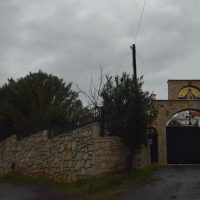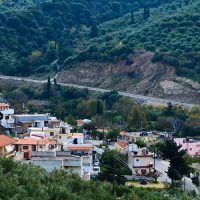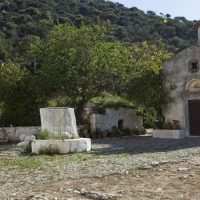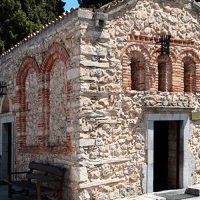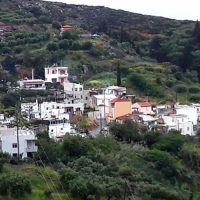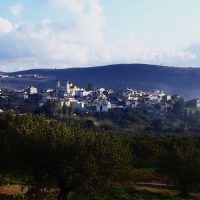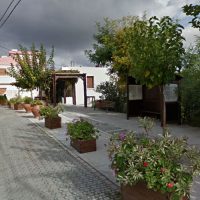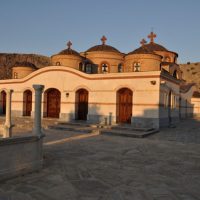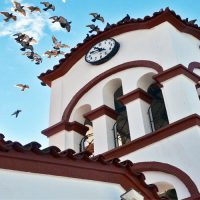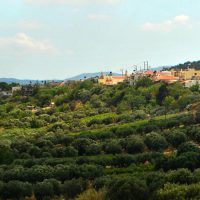Description
 Agarathos Monastery is located 23 km southeast of Heraklion. It is built in a verdant area near the village of Sgourokefali at Soros Pantelis hill, at an altitude of 538m. The monastery is built with a fortified architecture while the temple is of the cruciform type with a dome. The main building is a two-aisled church. One aisle is dedicated to the Assumption of the Virgin and the other one to Agios Minas. The great feast of the monastery takes place on the celebration of the Virgin Mary on 15th of August.
Agarathos Monastery is located 23 km southeast of Heraklion. It is built in a verdant area near the village of Sgourokefali at Soros Pantelis hill, at an altitude of 538m. The monastery is built with a fortified architecture while the temple is of the cruciform type with a dome. The main building is a two-aisled church. One aisle is dedicated to the Assumption of the Virgin and the other one to Agios Minas. The great feast of the monastery takes place on the celebration of the Virgin Mary on 15th of August.
The monastery was named after the Jerusalem sage bush (agarathia in the Cretan dialect) under which it is said that an ancient icon of Virgin Mary was found and at that place the church was later built. Today, in front of the sanctuary of the temple, there is a pomegranate under which the monks keep a candle lit on its trunk. According to the tradition, the famous “Agarathos pomegranate” is the original Jerusalem sage bush which was grafted by the monks of that time, transforming it into a tree in a miraculous way.
Agarathos Monastery is one of the oldest monasteries in Crete. There is no exact information about the date of the erection of the monastery. It is estimated, though, that it was founded in the Second Byzantine period (961-1204 AD).
Originally, it was a small monastery that belonged to the Kallergis family, who granted it to Abbot Nifon Notaras in 1504.Nifon Notaras reorganized and turned the monastery to a very rich one. In the middle of the 16th century, it was fortified and obtained a fortress form with three entrances. Nowadays, there are many surviving elements from the old fortress complex. The visitor can see the date 1585 AD at the northern gate of the monastery and the date 1583 AD at the southern one.
The monastery, during the Venetian domination, was considered to be one of the richest in Crete, resulting to acquire many small and large monasteries in the wider region as glebe land. At the same time, the monastery was an important spiritual center in which young students, monks and lay people were studying and working by reproducing manuscripts to save them and enrich the libraries of the monastery. It was also proven that the monastery had a very important library according to manuscripts and documents found in the Biblioteca Nazionale Marciana (library and Renaissance building) in Venice in 1532 and in the British Museum in 1559, accordingly.
Moreover, the monastery played an important role during the period of the Ottoman domination as many revolutionary movements against the Turks were developed. In the revolution of 1821, the Turks slaughtered the monks and set fire to the buildings. The monastery remained deserted for a few years, and after the end of the revolution, the monks who had been saved from the slaughter settled there again. In the monastery, a school was founded again after 1860 and the students from the surrounding villages of the area were studied at it, while during the revolution of 1866, the monastery became the base of a great Cretan hero, Anthonis Trifitsos who was killed in the battle. Its amulet and other relics were kept in the monastery today. Eventually, the temple was rebuilt in 1894, and by the end of the Ottoman domination, a new period of acme of the monastery began.
Significant ecclesiastical figures that linked their name to Agarathos are Meletius Pegas (Patriarch of Alexandria), Cyril Lucaris (Ecumenical Patriarch), Gerasimos Palaiokapas (Bishop of Crete), the scholar Joseph Bryennios and present-day Patriarch of Alexandria, Theodore II.
Nowadays, the visitor can see parts of the monastery, the cells, the temple and the extraordinary ecclesiastical museum and library that the monastery possesses exhibiting many ecclesiastical displays, historical objects and manuscripts.
Attributes
- Travel activities RELIGION, Religious Museum
- Location Episkopi Region
- Listing categories RELIGION



